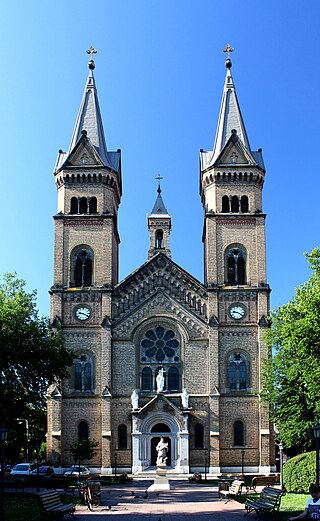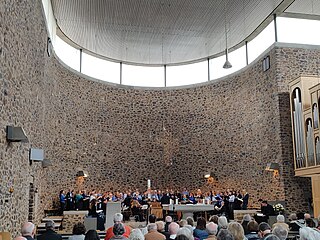
Dornbirn is a city in the westernmost Austrian state of Vorarlberg. It is the administrative centre for the district of Dornbirn, which also includes the town of Hohenems, and the market town Lustenau.

Au is a town in the Bregenz Forest in Vorarlberg (Austria).

Markt Schwaben is a town in Bavaria, Germany. It lies roughly 23 km east of Munich on the northern edge of the Upper Bavarian district of Ebersberg. Neighbouring communities are Anzing, Forstinning, Pliening and Poing, as well as Finsing, Ottenhofen and Pastetten.

The Millennium Church, officially known as the Church of the Blessed Virgin Mary, Queen of Heaven, is the largest Roman Catholic church in Timișoara, located in the Romans' Square in the Fabric district. It was built to commemorate 1,000 years since the formation of the Hungarian state, hence its name Millennium. At present, Holy Masses are celebrated in Hungarian, German, Romanian and every Saturday evening in Italian.

The Roman Catholic church of St. Mary Magdalene in Lviv, Ukraine, is located west of the city's Old Town, by the Lviv Polytechnic.

Haselstauden has been the fourth district of Dornbirn, Austria since 1902, when Dornbirn was given the status of municipality. It's also the city's northernmost district.

Stadtpfarrkirche St. Johann is a Roman Catholic parish church in the city of Rapperswil, canton of St. Gallen, Switzerland.

St. Martin is the name of a Catholic parish and church in Idstein, Rheingau-Taunus-Kreis, Germany. The official name of the church is Katholische Pfarrkirche St. Martin. The name of the parish became St. Martin Idsteiner Land on 1 January 2017, when it was merged with five other parishes. The parish is part of the Diocese of Limburg.

Rheingauer Dom is the colloquial name for the Catholic parish church in Geisenheim, Germany. Officially Pfarrkirche Heilig Kreuz, the large church in the Rheingau region is called Dom although it was never a bishop's seat. The present building was begun in the 16th century, but major features such as an expansion of the nave from three to five vaults, the towers, the organ and several altars were added in the 19th century. The parish is part of the Diocese of Limburg.

The church of St. Gumbertus, named for Saint Gondelbert, is one of the central city churches of Ansbach, Bavaria, together with the neighboring St. Johannis. Located in the Altstadt of Ansbach, St. Gumbertus, now a Lutheran church, was originally the church of a monastery that was founded by St. Gumbert around 750. Today it serves as a venue for concerts of the music festival Bachwoche Ansbach. The church contains the oldest structures in Ansbach and is considered Ansbach's city symbol.

The Lichtental Parish Church is the Catholic parish church of Lichtental, now part of Vienna, Austria. Officially the Lichtentaler Pfarrkirche zu den heiligen vierzehn Nothelfern, it is dedicated to the Fourteen Holy Helpers. The church has elements of Baroque and Neoclassical architecture. It is also known as the Schubertkirche, because Franz Schubert was baptised there in 1797 and wrote several compositions for use in the church, including his first Mass for the centenary, first performed on 25 September 1814.

St. Ulrich is a Roman Catholic parish and church in Neubau, the 7th district of Vienna, Austria. The official name of the church is Pfarrkirche hl. Ulrich und Maria Trost, it is also known as Ulrichskirche. The Baroque hall church with two towers was built in 1721. It is consecrated to St. Ulrich and St. Mary.

St. Valentin is the common name for the Catholic parish church and Basilica minor Basilica of SS Dionysius and Valentinus in Kiedrich in the Rheingau, in Hesse, Germany. It was built at the end of the 15th century in the Gothic style. Its organ is one of the oldest playable organs in Germany. The church was a pilgrimage destination for people with epilepsy and therefore has notable carved wooden laity stalls, including one decorated with the "Gerechtigkeitsspirale".

The cathedral Maria Himmelfahrt is the parish church of the South Tyrolean capital Bolzano and cathedral of the Diocese of Bozen-Brixen. While the Bishop has resided in Bozen since 1964, the cathedra and the cathedral chapter remain in Brixen. Maria Himmelfahrt is therefore with Brixen Cathedral co-cathedral of the diocese.

St. Nikolaus von Flüe is the name of a Catholic church in Wörsdorf, part of Idstein, Rheingau-Taunus-Kreis, Germany. The official name of the church is Katholische Pfarrkirche St. Nikolaus von Flüe. When it was dedicated, the name was St. Nikolaus-von-Flüe-Friedenskirche, designating it as a peace church. The Wörsdorf parish belongs to St. Martin Idsteiner Land. The church, the first Catholic church in Wörsdorf, was designed by Johannes Krahn, and consecrated in December 1962.

St. Martin in Moosach, part of Munich, Bavaria, Germany, is the name of a Roman Catholic parish which has two churches dedicated to Martin of Tours, the old Alte Pfarrkirche St. Martin, one of Munich's oldest churches, and the new Neue Pfarrkirche St. Martin. The new church was dedicated in 1924.

The Church of the Holy Name of Blessed Virgin Mary is a Catholic church in the Mehala district of Timișoara in western Romania. Holy Masses are celebrated in Hungarian, German and Romanian, with the possibility of being celebrated in Bulgarian in a week's time.

St Wigbert's Church in the city of Erfurt in Thuringia, Germany, is a Roman Catholic church building dating from the 15th century. Today, it is a subsidiary church of the Catholic parish of St Lawrence's Church.

The parish church of Kainach bei Voitsberg, often called Kainach parish church, is the Catholic parish church of the parish of Kainach, located in the municipality of Kainach bei Voitsberg in western Styria, Austria. The church, dedicated to St. George, belongs to the pastoral area of Voitsberg in the diocese of Graz-Seckau.
The Roman Catholic Parish Church of Dornbirn-Hatlerdorf' stands in the district of Hatlerdorf in the municipality of Dornbirn in the Austrian state of Vorarlberg. It is dedicated to Saint Leopold and belongs to the Deanery of Dornbirn in the Diocese of Feldkirch. The building is under monument protection.





















